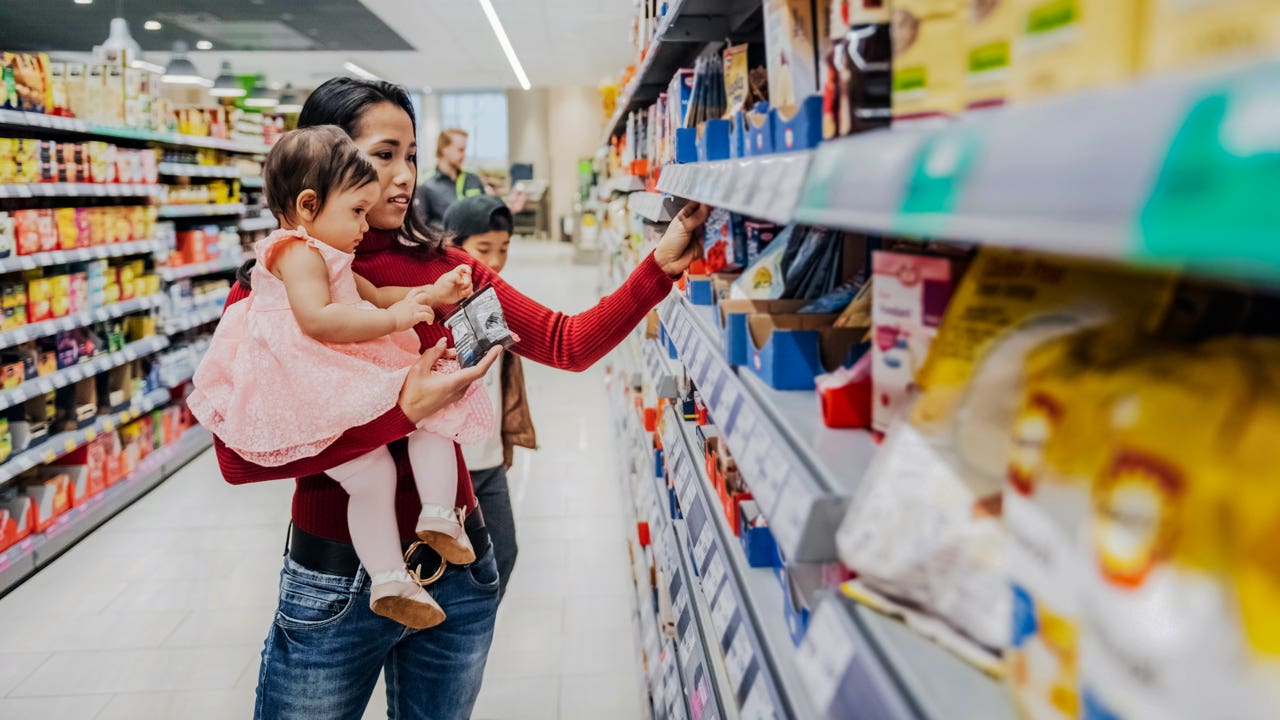Use your credit card rewards to minimize the impact of inflation

The Bankrate promise
At Bankrate we strive to help you make smarter financial decisions. While we adhere to strict , this post may contain references to products from our partners. Here's an explanation for . The content on this page is accurate as of the posting date; however, some of the offers mentioned may have expired. Terms apply to the offers listed on this page. Any opinions, analyses, reviews or recommendations expressed in this article are those of the author’s alone, and have not been reviewed, approved or otherwise endorsed by any card issuer.
Key takeaways
- Inflation continues to pick up, with the U.S. seeing price increases across consumer goods and services.
- These price increases mean nearly everything we buy now costs more than it did a few years ago, including groceries, travel, fuel and services.
- Having a range of credit cards in your wallet lets you earn cash back on your regular purchases and bills, which you can redeem to offset these higher prices.
- Remember that credit card interest rates are sky high, and you’ll only “get ahead” with rewards if you pay your credit card bill in full each month.
Overall inflation of consumer prices increased 3.4 percent over the 12 months leading up to December 2023, according to the latest Bureau of Labor Statistics data. the largest increase in over 40 years. After that, regular inflation numbers finally slowed, with the most recent figure coming in at 4.0 percent during the 12 months leading up to May of 2023.
Consumers are bearing the brunt of rising prices and interest rates, unfortunately. And while this isn’t great news, Americans have weathered these storms before. From coupon clipping to discount shopping, we know there are ways to soften the blow of inflation.
By using your credit cards strategically, you may be able to earn discounts in common spending categories where prices are rising. Here are tips on how you can use your credit card rewards to save on food and fuel spending.
Inflation’s impact on food and fuel
How much are you spending on groceries and gas nowadays? The average family of four with two adults and two kids ages 8 and 10 is now spending $1,306.30 per month on a moderate food spending plan, according to November 2023 data from the USDA.
However, recent stats show inflation has likely increased these averages quite a bit. The cost of food increased an average of 4.9 percent from July 2022 to July 2023, according to the latest BLS statistics, while energy prices appear to have decreased 12.5 percent in the same period.
Choose the right credit card to offset rising prices
Although price increases are unsettling, the good news is that credit cards can help you out. Plenty of cards offer rewards on groceries and food delivery, dining out, gas at the pump and other common spending categories.
In some cases, you can find a credit card that covers multiple categories— such as a flat-rate cash back card that rewards you with the same rate of cash back on all spending. No matter which credit card you choose, you’re able to earn rewards on the food and fuel spending you would’ve done anyway.
Top credit cards to consider for grocery, grocery delivery, dining and gas spending
Chase Sapphire Preferred Card
-
With the Chase Sapphire Preferred® Card, you’ll get 3X points on online grocery purchases (excluding Target, Walmart and wholesale clubs), 3X points on dining (including takeout and eligible delivery services) and 3X points on select streaming services. Plus, you’ll earn 5X points on travel booked through Chase Ultimate Rewards and on Lyft rides (through March 2025), 2X points on general travel and the standard 1X points on everything else.
This Chase card comes with other great benefits and credits, like a 10 percent anniversary point bonus and the ability to redeem your points for 25 percent more value when booking travel through the Ultimate Rewards portal.
However, the fact that you can earn more rewards on both groceries and dining with this card is a big deal. Plus, you could be eligible for a free 12-month DoorDash DashPass membership if you don’t already have one (must activate by Dec. 31, 2024). Note, any order you place for delivery will still earn 3X points.
Since this card lets you use your rewards for statement credits at a rate of one cent per point, you could ultimately redeem points to knock down your credit card bill after you shop.
Bank of America Customized Cash Rewards credit card
-
The Bank of America® Customized Cash Rewards credit card earns 3 percent cash back on purchases in your category of choice and 2 percent back at grocery stores and wholesale clubs (on up to $2,500 in combined 3 and 2 percent category purchases each quarter, then 1 percent).
Better yet, new cardmembers can earn a $200 cash bonus after spending $1,000 on purchases in the first 90 days of account opening. If you’re a Bank of America Preferred Rewards member, you can earn up to 75 percent more cash back on all purchases (depending on your membership tier level).
This card is a great choice for those who need more flexibility on spending categories, as it comes with 3 percent back in one category of your choice that you can change once per month. With this strategy, you can pair your grocery earnings with rewards on purchases such as travel, home improvement, gas & EV charging stations, online shopping (including Cable, Streaming, Internet and Phone services), drugstores or dining, based on what matches your anticipated spending for the month.
Blue Cash Preferred Card from American Express
-
If you’re looking to earn rewards on your grocery and gas spending, the Blue Cash Preferred® Card from American Express is a great option for both categories. You’ll earn 6 percent cash back at U.S. supermarkets on up to $6,000 per year (then 1 percent back) and 6 percent back on select U.S. streaming subscriptions. You’ll also get 3 percent back on U.S. gas station and transit spending and 1 percent back on all other purchases.
The Amex Blue Cash Preferred is ideal if you have a moderate grocery budget, since there’s a $6,000 cap on grocery spending each year — meaning a maximum of $360 in cash back earnings within that category. Not only can you save on gas, but if you use public transportation, you’ll earn 3 percent back on that spending as well.
Citi Custom Cash Card
-
The Citi Custom Cash® Card doesn’t have a bonus category for groceries or gas, per se, but it does deliver 5 percent cash back on your top eligible spending category (up to $500 per billing cycle) out of 10 top spending category options. Gas stations, select travel costs and select transit expenses are three of these top 10 categories — and even if you hit the $500 limit, you’ll still earn 1 percent back.
Since many consumers’ top spending categories naturally fall under food or fuel, it can be relatively easy to hit $500 each month and earn 5 percent back (which you’ll receive in the form of basic Citi ThankYou points, despite this card being marketed as a cash back card). These points can be redeemed for cash with a direct deposit, check or statement credit. You can also redeem your points for gift cards, travel through Citi or eligible purchases on Amazon with Shop with Points.
Costco Anywhere Visa Card by Citi
-
The Costco Anywhere Visa® Card by Citi* offers 4 percent cash back on eligible gas and EV charging purchases, including gas at Costco (for the first $7,000 per year, then 1 percent), plus 3 percent back at restaurants and on eligible travel purchases, 2 percent back on all Costco and Costco.com purchases and 1 percent back on everything else.
This card is ideal for die-hard Costco customers, only because redeeming rewards is pretty strict. You’ll receive your rewards as a single credit card reward certificate, which can be redeemed once a year in February, in-store only. If you frequent Costco enough, this card might still be worth it.
If you’re into wholesale clubs but are more of a Sam’s Club fan, for example, the Sam’s Club® Mastercard® might be worth considering as it offers a similar rewards structure and redemption options.
Other money-saving strategies
Consider a rotating bonus category card
If you aren’t particularly sold on any of the cards above, you might be interested in a rotating bonus category card like the Discover it® Cash Back, which offers 5 percent cash back on activated rotating bonus categories each quarter (on up to $1,500 in spending per quarter, then 1 percent). This card usually includes gas stations, grocery stores, and restaurants as quarterly bonus categories; however, to receive 5 percent back in any quarter, you must activate the category.
If you’re interested in applying, review our guide to Discover’s cash back calendar to plan ahead for future categories.
Double dip with cash back apps
This is somewhat of an advanced strategy — not because it’s complicated, but because it requires an extra step and some planning ahead.
You’ll find a number of cash back apps you can use to deepen your grocery and gas discounts. Ibotta and Fetch Rewards are just two that allow you to save money on groceries while still earning credit card rewards on those purchases. For gas, there are plenty of loyalty programs, usually paired with your local grocer, to help you save at the pump while still earning credit card rewards on your fuel spending.
Put together a solid budget (if you haven’t already)
One way to minimize the impact of rising prices on your finances is to set up a spending plan — and that doesn’t always require you to cut something out. You may be able to move expenses around or find ways to earn extra money to make up for the shortfall. The point is to take stock of your spending and figure out what you can change to fare better in the prevailing circumstances.
Avoid credit card interest at all costs
You won’t benefit from rewards if you’re carrying a balance on your card from month to month, so you should only try out the rewards strategies on this list if you can pay your balance in full every billing cycle. If you have credit card debt to consolidate, on the other hand, consider transferring your high-interest debt to a card that offers 0 percent interest for a limited time. The best balance transfer credit cards offer 0 percent introductory periods of 15 months or longer.
By consolidating debt on a balance transfer credit card, you can pay down debt faster and save money on interest — as long as you’re serious about the process.
The bottom line
Rising prices have long been a part of our lives. However, with some planning and creativity, there’s a good chance you won’t feel the impact as much as you initially anticipated. Taking advantage of the best credit cards for cash back rewards or points on groceries, dining and gas spending, along with other financial strategies, is a good step in the right direction.
*Issuer-required disclosure statements
Information about the Costco Anywhere Visa® Card by Citi has been collected independently by Bankrate and has not been reviewed or approved by the issuer. Information about the Bank of America® Customized Cash Rewards credit card was last updated on January 18, 2024.
Related Articles


Consumer prices are soaring. Here are the best ways to protect your savings

